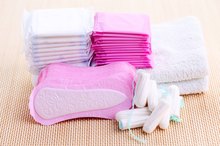10 Crazy Facts About Our Periods
If you have a uterus, you will spend (on average) more than 2,000 days of your life menstruating. While periods have been around since the dawn of time, menstruation has been considered taboo throughout history. Menstrual stigma persists around the world, but thanks to new innovations and heightened awareness, the (crimson) tide is beginning to turn.
Read on to find out some strange facts about our periods and new innovations that are changing the course of period history for the better.
1. They Were Once Considered Lunar Anomalies
In ancient and medieval times, menstruation was considered bleeding without injury that corresponded with changes in the moon. While this may sound like mythical musing, environmental cues play a well-documented role in regulating menstruation, according to gynecologist Dr. Christiane Northrup.
“Many women find that they are at peak expression in the outer world during the first half of their cycles,” she writes, “which coincides with the waxing of the moon until it’s full, until ovulation.” While research is limited, one small Scandinavian study published in the 1980s does support the lunar-menstrual connection.
Related: How the Moon Affects Your Feminine Body
2. They Helped Early Humans Track Time
When Were Women Allowed to Play Golf?
Learn More
Long before the advent of watches, planners and smartphone apps, periods may have helped ancient civilizations track the passage of time — all thanks to a tool most likely created by a woman. “The earliest attempts at calendars are thought by some archeologists to be lunar/menstrual calendars,” said Susan Harper, a feminist scholar and anthropologist in Dallas. Ancient bones with tally marks, including Lebombo and Ishango bones, seem to track the 28-day lunar cycle, she added.
3. Period Literally Means ‘That Time’ of the Month
The word “menstruation” dates back to the late 1600s and derives from the Latin word “menstruus,” which means “monthly.” Over time, the monthly shedding of the uterine wall became known as “menstrual periods” (i.e., the the period of time in which Aunt Flo visits). While the term is still used, “menstrual” is often dropped, leaving simply “periods.”
Fun word-nerd fact: The word “tampon” derives from “tampion,” the medieval French word for a plug or stopper.
4. Menstrual Shame Is a Huge Problem
How to Get Rid of Menstrual Period Odor
Learn More
Periods have been cloaked in shame for centuries. While there are exceptions — some cultures viewed menstruation as sacred — menstruating women were typically considered cursed in ancient times. Men who recorded history often omitted menstruation altogether, as though it had never happened. Even today, countless girls in countries like India and Uganda drop out of school due to bullying around menstruation or a lack of sanitary products or bathrooms.
Related: A Bleeding Shame: Why Is Menstruation Still Holding Girls Back?
5. Bandages Became (Secretive) Pads
The first menstrual products likely consisted of sticks wrapped in foliage or wads of cloth. Finally, in 1888 Johnson & Johnson developed the first commercial disposable pads, called Lister’s Towels. Embarrassment around purchasing the pads prompted the company to shift to more discreet packaging and the less telling name, Nupak.
Around this time nurses began creating highly absorbent pads out of wood pulp bandages. Later on, Kotex used the same material to create their first pads.
Related: The Product That Dared Not Speak Its Name
6. Thank a Ballerina for the Modern Tampon
Like pads, tampons haven’t changed much over the years. Devices consisting of absorbent material with a string attached were documented in 18th century Europe. A study published in 1879 by the British Medical Journal included “Dr. Aveling’s Vaginal Tampon-Tube” as a new innovation. Today’s commercial tampons first entered the market in 1929. Creator Dr. Earle Cleveland was inspired by his ballerina wife, who had struggled to fit bulky pads in her leotards.
7. Women Are Creating Alternatives
It may have taken centuries, but numerous female-led companies now create and sell alternatives to traditional feminine-hygiene products. Absorbent underwear (known as “period panties”) and vaginally insertable menstrual cups allow wearers to bypass pads and tampons for up to 12 hours.
“Menstrual cups are very effective and designed with a focus on minimizing consumption and benefiting our environmental-waste burden,” said Dr. Barb DePree, a gynecologist in Holland, Michigan. You simply fold and insert the cup into your vagina, then empty and rinse it twice or more per day.
Related: 5 New Products That Will Make You Ditch Tampons for Good!
8. Natural Pads and Tampons May Be Beneficial
Most feminine-hygiene products consist of of cotton, rayon and synthetic fibers, but U.S. makers aren’t required to disclose specific ingredients. If you want to avoid potentially risky chemicals, you can now use natural alternatives. The vagina is permeable and absorbs chemicals, said DePree, so the appeal of natural, organic or chemical-free products makes sense. While information is lacking on any risks and benefits of traditional and natural alternatives, she feels natural options can benefit anyone with known sensitivities.
“For decades women have been using tampons with no obvious widespread detriment, to our present day knowledge,” she said. “We need clinical trials to say for certain there are health risks [or] benefits.”
9. Hormonal Interventions Can Help
The modern menstruator can not only access a broader range of hygiene products, but also effective ways to manage bothersome symptoms. “The hormonal interventions we can now offer to patients with heavy, irregular or painful periods are extremely beneficial,” said Dr. Sheila Loanzon, a gynecologist in San Jose, California.
These include estrogen- and progesterone-based methods, such as oral pills, transdermal patches and intervaginal rings, progesterone-only pills and intrauterine devices (IUDs). “All of these options have risks and benefits, depending on what the patient is looking for,” she added. Your ability to properly take a medication, your comfort with estrogen use and your family medical history can help determine your best option.
10. Some Men Menstruate Too
Spend an hour flipping through magazines or TV channels and you’ll likely see menstrual products advertised. While the ads vary in specifics, they typically share one trait: They all feature women. Females aren’t the only ones who menstruate, though. Many trans men do too. “I understand why companies do this,” said TJ, a transgender man in Los Angeles.
“Our culture is just starting to come around to accepting trans people,” he said. “That said, I’d love to see it change. Having periods doesn’t make me less of a man.” When trans people feel included and respected, they tend to be less prone to complications of bullying and discrimination, such as depression and homelessness.
Knowledge Is Power
Knowledge is power when it comes to menstruation. If you’re a parent, consider talking to your child about her period before puberty. If you carry some amount of menstrual shame or anxiety about discussing it yourself, aim to minimize it. Seeing menstruation for what it is — a natural process worthy of respect — benefits everyone.
What most surprised you about the history of periods? What’s your favorite new product? Let us know in the comments!
Related Articles
- The regulation of menstrual cycle and its relationship to the moon
- Oxford English Dictionary: Tampion
- Online Etymology Dictionary: Menstruation
- Fact Retriever: Menstruation Facts
- Vitality A Brief History Of The Menstrual Period: How Women Dealt With Their Cycles Throughout The Ages
- Reports And Analyses And Descriptions Of New Inventions In Medicine, Surgery, Dietetics, And The Allied Sciences
- The Right Chemistry: Tampons, in space and on Earth
- Menstrual Tampons and Pads: Information for Premarket Notification Submissions
- David Woolley/DigitalVision/Getty Images









